You may not find this terribly rewarding unless you're included here, so this is a good time for casual and random browsers to turn back before they get too caught up in the sweep and majesty of the proceedings and can't let go.
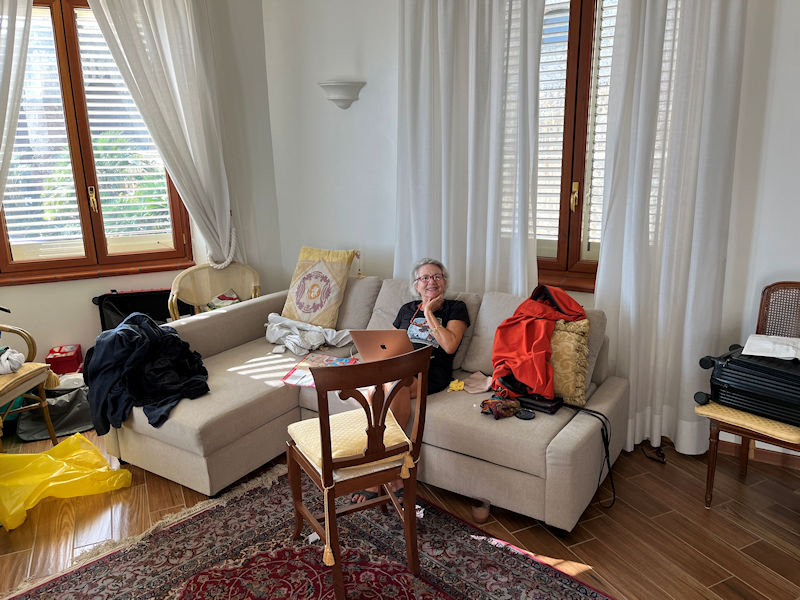
-- Hey, what say we go up to see the Monastery today?
-- Oh, splendid idea!

So, it's up-and-at-'em early (though not too early) (about lunchtime). The 'Certosa e Museo di San Martino' is on the right side up on the Vomero hill.
The Carthusian Order was founded for both monks and nuns by Bruno of Cologne in 1084, named for their first hermitage in the Chartreuse Mountains in the French Alps. Their monastery is called a 'certosa' in Italian, a 'chartreuse' in French, and a 'charterhouse' in English.
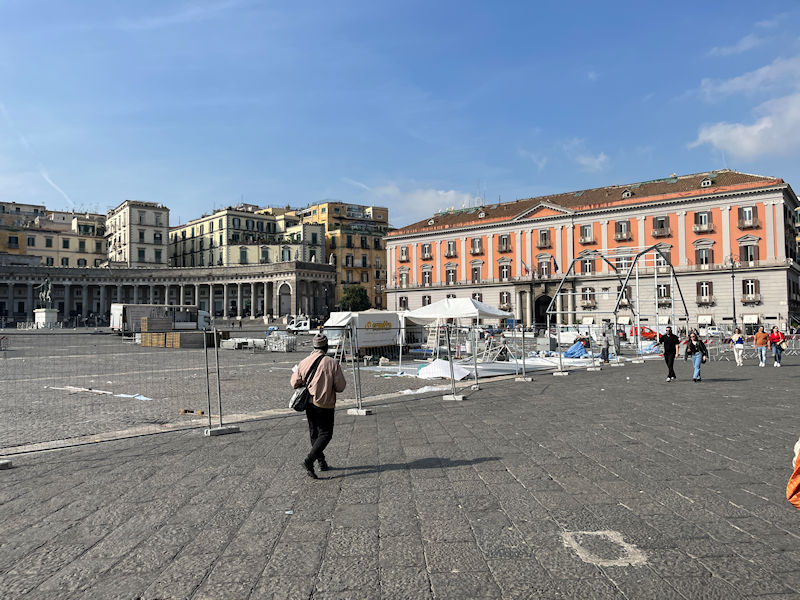
Yesterday's medical extravaganza has all come down overnight. At least as far as public health goes, the Neapolitans are on their own now (just kidding, it was fabulous).

One of the three funicular railways up the hill, this is the Funicolare Centrale. The one in the center. Costs nearly nothing.
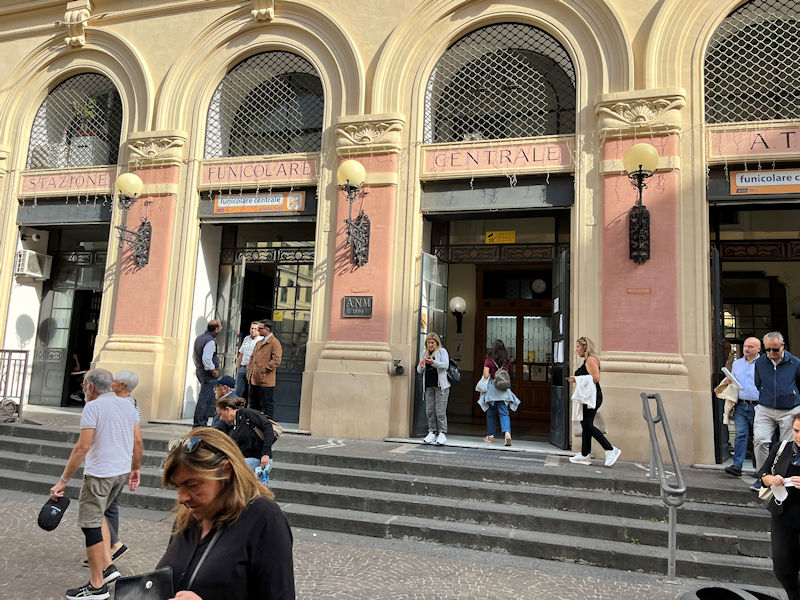
And arrives quickly to the top station on Via Renato Lordi, then we turn a quick right . . .

. . . up the Piazza Aldo Masullo and . . .
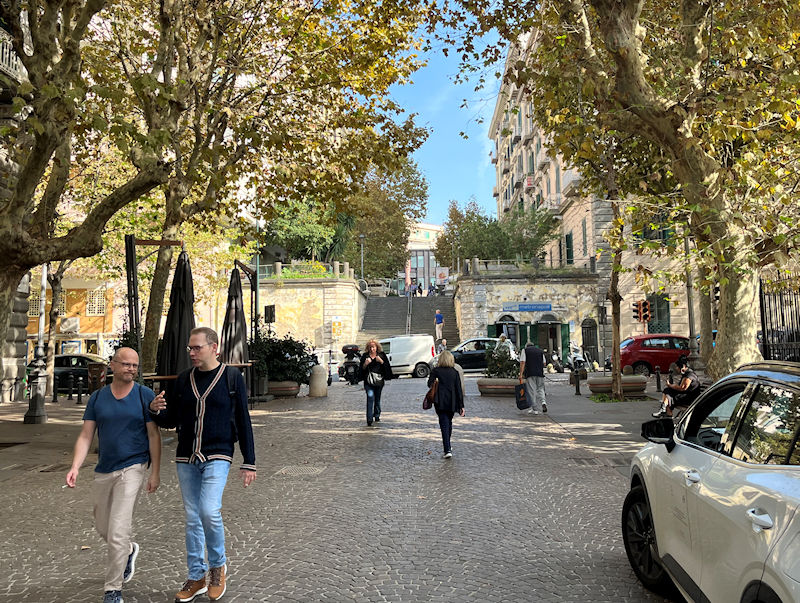
. . . then a few more flights of stairs (a few have escalators alongside, like this one) . . .

. . . and then, after little jog round the castle on the Via Annibale Caccavello, we trot down the dead-end Via Tito Angelini past the entrance to the Castel Sant'Elmo. (Our last visit is here, an earlier one here.)

An impressive building, the last one overlooking the city before the dead-end Largo San Martino, which is . . .

. . . here. That's the precipitous walk- and stairway down into town.
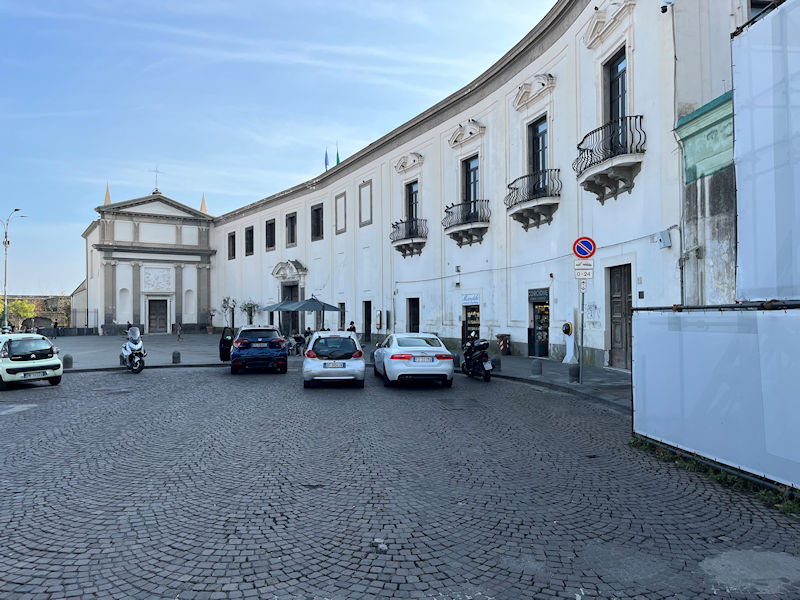
And here's the entrance to the monastery. The concept of the new monastery for the Carthusian order originated by 1325, apparently with support from Charles of Anjou, Duke of Calabria, son of King Robert the Wise, and work proceeded based on Carthusian architectural principles on the crest of the Vomero hill overlooking the city until it was completed and inaugurated by Charles' daughter, Queen Joanna I, in 1368.
At the end of the 16th century, Giovanni Antonio Dosio (1533-1611), who'd long worked in Rome and Florence, was recruited by the Viceroy to come as 'royal architect' to Naples, where from 1590 he revised the monastery's Gothic medievalism into an impressive Renaissance idiom, and then Cosimo Fanzago (1591-1678), who worked almost entirely in Naples on many important projects and was considered to be the star architect and sculptor of the Baroque period in the city, revised and expanded Dosio's work significantly, in a Baroque manner, and was paid some 57,000 ducats by the Carthusians for 33 years of work on it.
The little chapel on the left is the separate 'Women's Church'.

Playing 'for a fit audience, though few' (to paraphrase John Milton)

We've gone through the entrance (consult the floor plan below) into the first courtyard, and now . . .

. . . we proceed into the principal church. The Carthusians were evicted from the buildings by the French occupation of Naples in 1799, possibly because of suspicions of Jacobin sympathies, but were able to come back in 1804. The rest of the century, however, they were in and out, unable to sustain themselves here successfully, and the Charterhouse was suppressed in 1860; in 1866, following the unification of the Kingdom of Italy, the state took the establishment over as a suitable place to celebrate Italian and Neapolitican history. A museum for the public was inaugurated here in 1867.

We're in the pronaos or vestibule, where so far we're not terribly impressed . . .

. . . but we continue . . .

. . . into the narrow Baroque nave. The side aisles were replaced by individual chapels and adorned by works by some of the foremost painters and sculptors who worked in or passed through Naples over the 17th and 18th centuries, including (for example) Guido Reni, Jusepe de Ribera, Luca Giordano, Pietro Bernina, Domenico Antonio Vaccaro, Andrea Vaccaro, Guiseppe Sanmartino, Giovanni Lanfranco, Micco Spadaro, Massimo Stanzione, the Cavalier d'Arpino, among others.
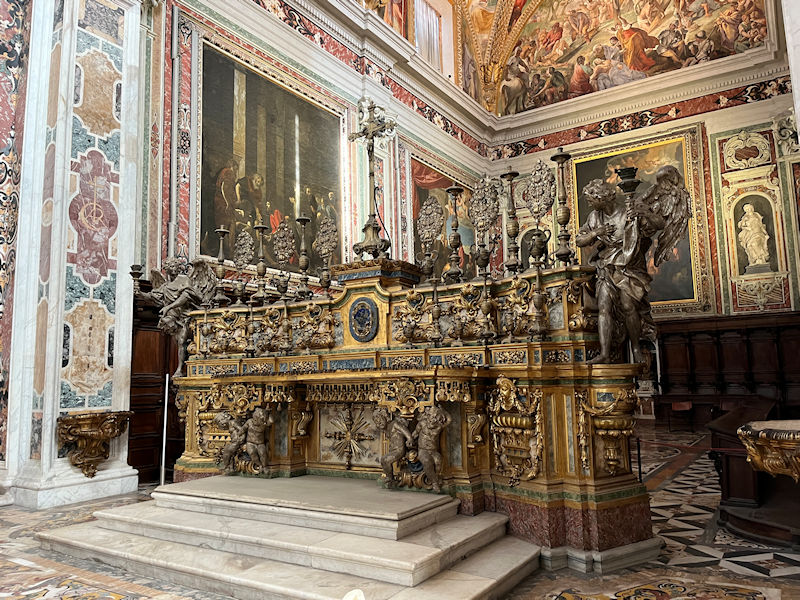
The wonderful altar, made of gilded wood painted to imitate marble, designed by the prolific Neopolitan Francesco Solimena and executed by Giacomo Colombo. The central painting (invisible here) is said to be by Guido Reni and statues on either side by Pietro Bernini and Giovann Battista Caccini.

A fabulous floor. About St Martin, by the way, he was apparently a real guy, born in 316 (or 336  ), died in 397, and was the third Bishop of Tours on the Loire, a Roman cavalry soldier who converted to Roman-style Christianity and defected in 361 to be a disciple of Hilary of Tours, then tried to convert Arians in Italy so unsuccessfully that he became a hermit ('living on herbs and wild roots') on an island near Albenga in Liguria. He then followed Hilary to Tours and was consecrated as third Bishop there, performing (we're told) many extraordinary miracles whilst enthusiastically ordering the destruction of pagan temples, altars, and sculptures. When he died, his shrine became the most prominent one in medieval France, and Charlemagne appointed the great scholar Alcuin as the abbot there in 796 (where he perfected the 'Carolingian miniscule' script).
), died in 397, and was the third Bishop of Tours on the Loire, a Roman cavalry soldier who converted to Roman-style Christianity and defected in 361 to be a disciple of Hilary of Tours, then tried to convert Arians in Italy so unsuccessfully that he became a hermit ('living on herbs and wild roots') on an island near Albenga in Liguria. He then followed Hilary to Tours and was consecrated as third Bishop there, performing (we're told) many extraordinary miracles whilst enthusiastically ordering the destruction of pagan temples, altars, and sculptures. When he died, his shrine became the most prominent one in medieval France, and Charlemagne appointed the great scholar Alcuin as the abbot there in 796 (where he perfected the 'Carolingian miniscule' script).
Amongst Martin's many innovative miracles, one has always stood out, how as a cavalry officer he came upon a badly clad beggar on the road on a cold day, and cut up his own cloak to share half of it with the poor man. (The cloak half that he kept was later carried into battle by the Merovingian kings.)
Unconfirmed fun fact: his half-cloak (capella = 'little cloak') was cared for in its reliquary by a cappellanu, and soon all priests in the military were called cappellani. As that evolved in French, it became chapelains, our military chaplains. The small churches that were built for the relic cloak were called capella, all of which (cloak or no cloak) became chapels.
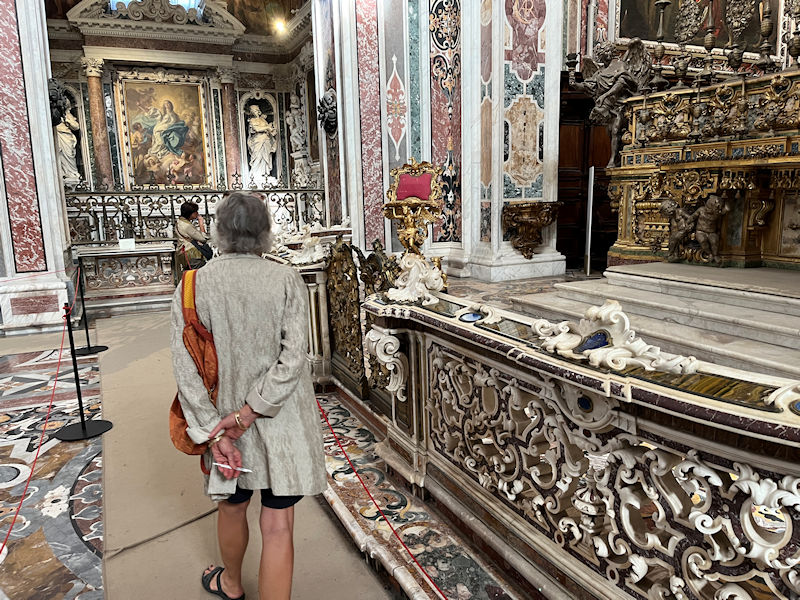
That's the Chapel of the Assumption straight ahead.

The ceiling over the small apse, with works evidently by Giovanni Lanfranco, and . . .
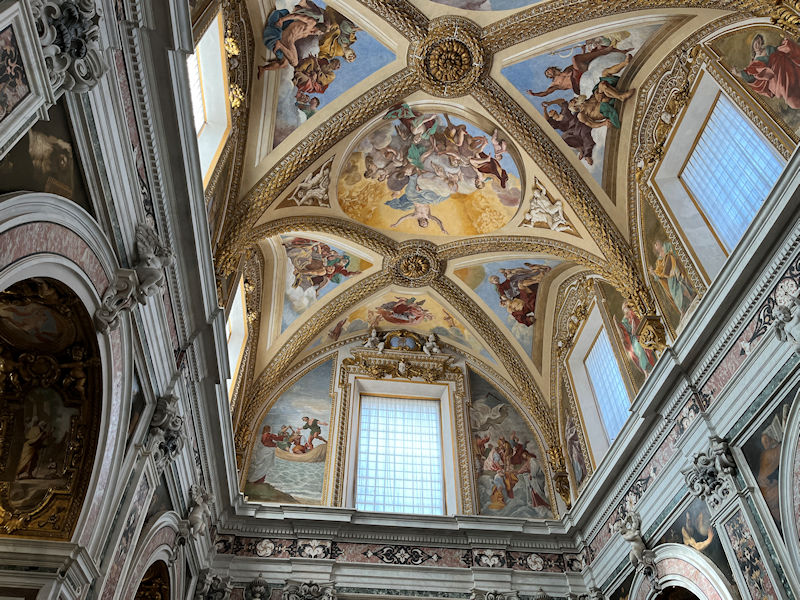
. . . the frescoes in the ceiling of the nave also by Lanfranco, 1636 to 1639. Other works in the vault are by the Cavalier d’Arpino and his brother Bernardino Cesari, completed between 1591 and 1596,

Above the entrance there is a painting of the deposition by Massimo Stanzione in 1638 and the two statues are by Cosimo Fanzago.
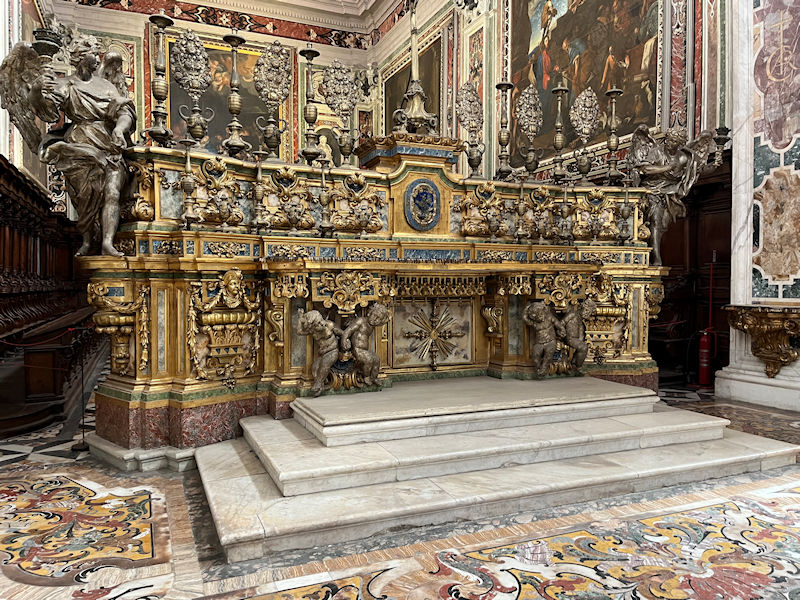
That really is neat -- it looks like you could climb into it and sail it to Peter Pan's Neverland.

The Cappella dell'Assunta, Chapel of the Assumption of Mary into Heaven, was begun by Caracciolo in the 1630s and completed in about 1756 by Francesco de Mura and Giuseppe Sanmartino. Amongst the related works all round are three scenes of the miracles of the Virgin aiding the Carthusian order.
Giuseppe Sanmartino (aka Sammartino) of Naples (1720-1793), of Veiled Christ fame, is not to be confused with Giuseppe Sammartini of Milan (1695-1750), a noted oboist and composer who was in London from c.1730 to 1750, a collaborator with Handel and Haydn.
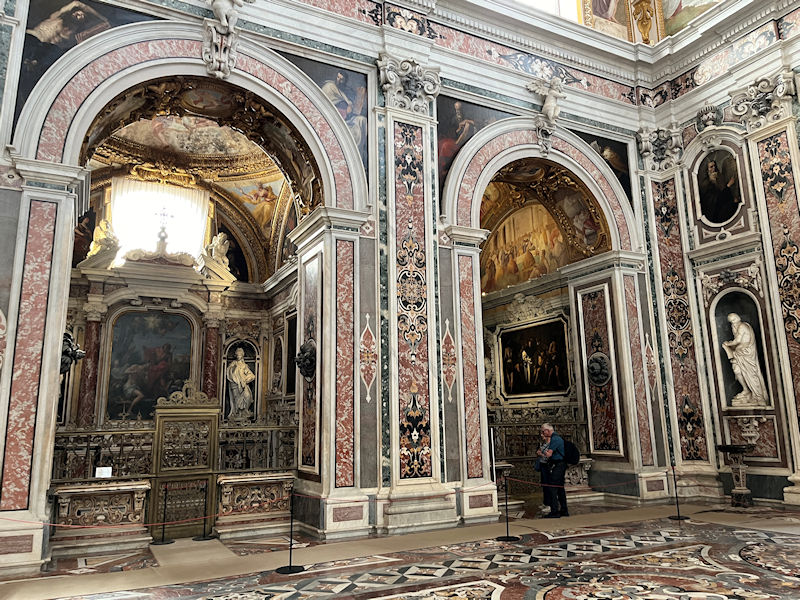
There are chapels facing onto the nave dedicated to the Assumption, San Bruno (founder of the Carthusian Order), and San Gennaro (Januarius, patron saint of Naples), on the other wall, and on this one, to San Martino, John the Baptist, and St Hugo. There are two other chapels as well, for the Rosary and for St Joseph, flanking the entry vestibule but not facing directly onto the nave.
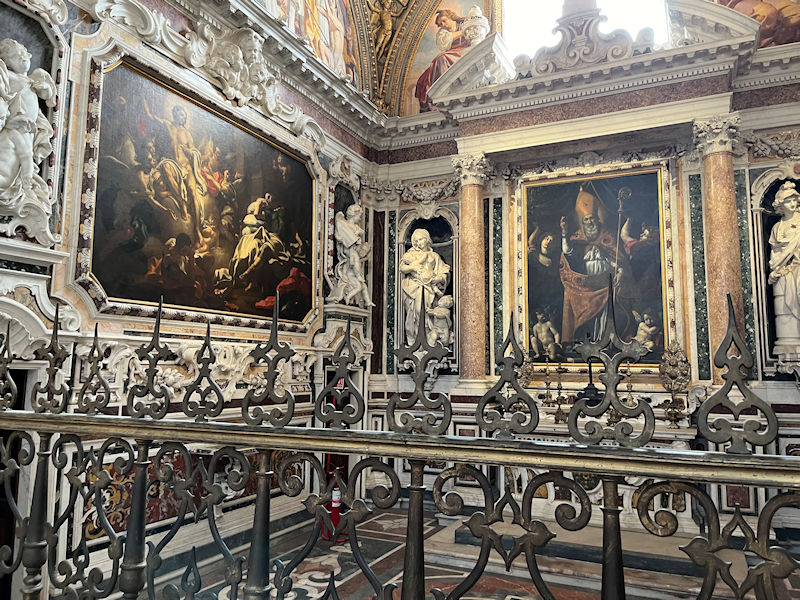
That's apparently St Martin himself, by Battistello Caracciolo in 1625; other frescoes here are by Paolo Finoglio in 1631 and by Francesco Solimena in 1732.

The San Gennaro Chapel is dated sometime after 1706, and the marble centrepiece is by Domenic Antonio Vaccaro.

These seem to be attributed to Battistello Caracciolo (1578-1635), a Neopolitican follower of Caravaggio, who between 1622 and 1635 painted a number of works in the chapels (of Assumption and of St Gennaro) and the Chapter Room, including an Adoration of the Magi and one of Saint Martin Bishop.
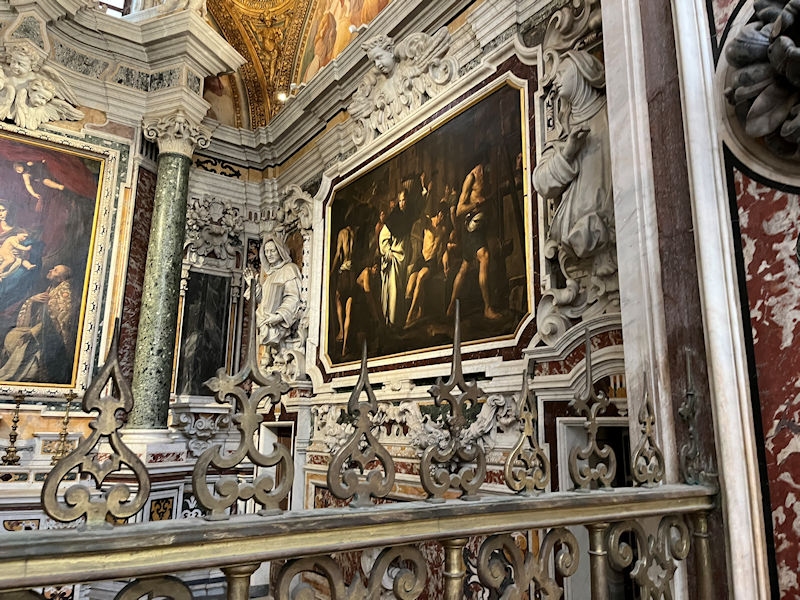

Those appear to be the chapels of John the Baptist and Saint Hugo (presumably St Hugo the Great (1024-1109), Abbot of Cluny).

The Castel Sant'Elmo looms above.

We're back out front in the courtyard, headed for the . . .
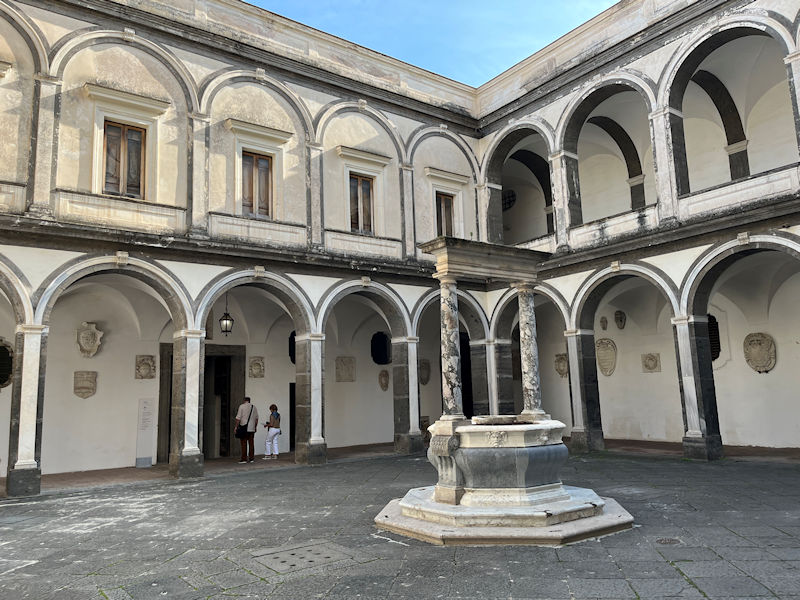
. . . smaller cloister of the Procurators, or Prosecutors, built by Dosio.

Decorations of grotesque masques, by Felice de Felice in 1605-1608.

The Royal Carriages Hallway

This fancy thing was commissioned 'at the turn of the 18th century' for use by the City Aldermen, continued in use until 1861 and was then presented to the museum by the city in 1865.
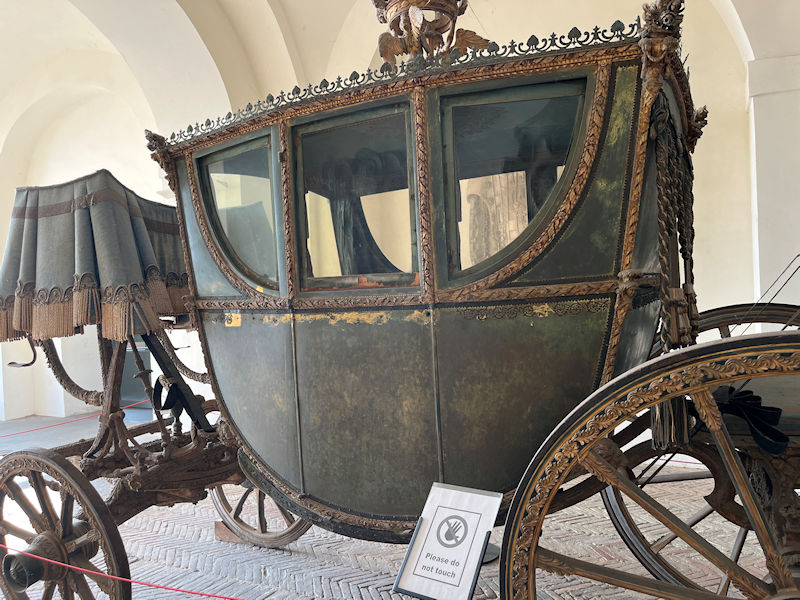
Whilst this one is apparently called a berlina di corte (i.e., invented in Berlin in the 17th century) and was made in 1804 or 1806, considered to have been the personal carriage of Ferdinando II and Maria Cristina di Savoia (from the info plaque).

The view from the Prior's balcony, the Royal Palace and Palazzo del Plebiscito at centre left and the Castel dell'Ovo next to the tree at the right.
We're entering now the Prior's Quarters, embodying both his personal spaces and reception areas for important guests, the library, a small study, and galleries housing the certosa's rich collection of pictures and sculptures (much of which was ripped off by French occupying forces in 1806 and dispersed before they could be recovered). Restorations made in 1995-1999 reinstated much of the original architectural structure after modifications for later museum layouts, and much of the present art comes from donations and museum purchases as well original properties.
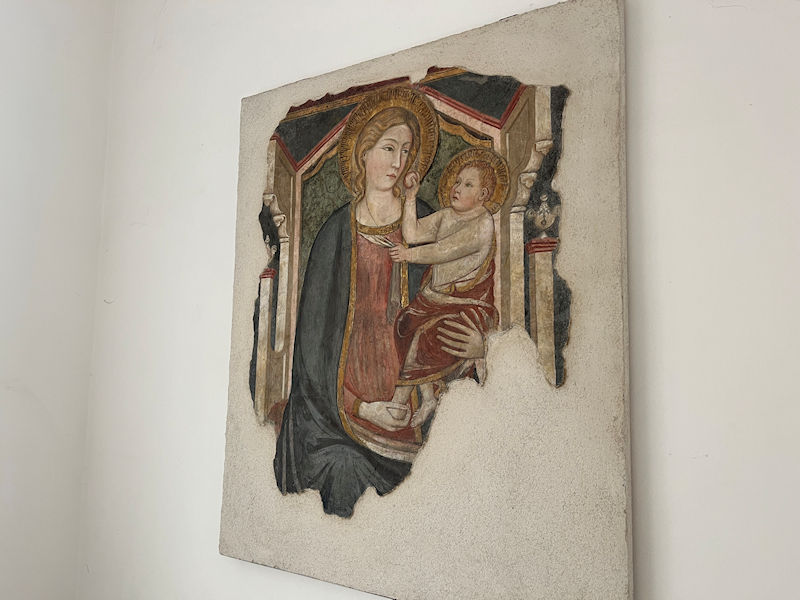
A good way to start out, first things first

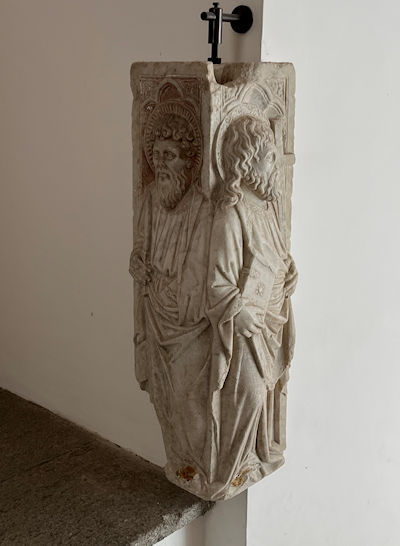

By an 'Ignoto napoletano', second half of the 15th century
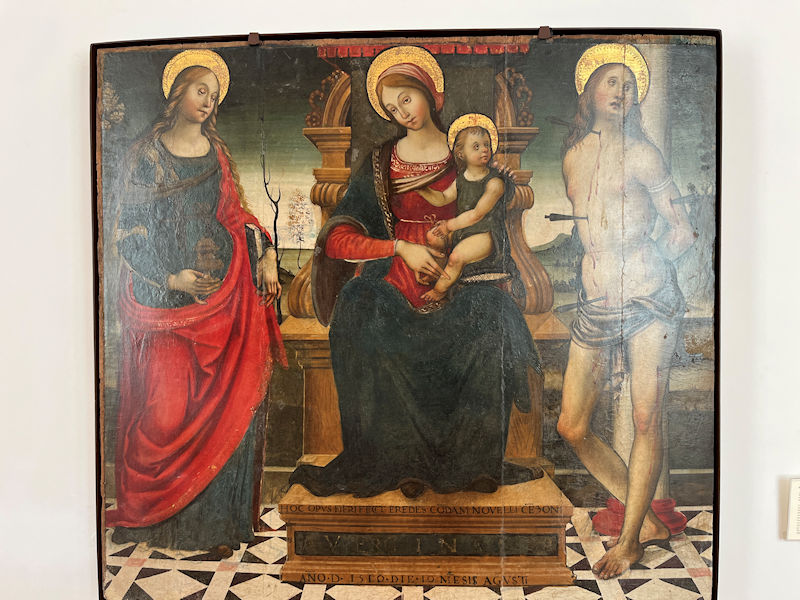
'Madonna and Baby enthroned with St Sebastian and Mary Magdalene' (1510), by Agostino Tesauro (active in Naples 1501-1546). The Baby Jesus's expression is fabulous.


This is the story about St Martin for which he's most famous -- whilst still in the cavalry, before his conversion, he meets a ragged beggar and cuts his own cloak in half to give the other half to the man. Protasio Crivelli (Milan, active 1497-1506), 'St Martin divides his mantel with a poor man' (c. 1500)

Jean Bourdichon (Tours 1457-1521), 'Madonna and Bambino and Saints John the Baptist and John the Evangelist (with) Crucifixion and Saints Archangel Michael and George' (1501-1504)

A beautiful corridor to somewhere


Pietro Bernini (1562-1629), 'Madonna and Child with St John' ('one of the most significant achievements of sculpture in Naples and in Italy spanning Mannerism and Baroque'). The base was designed by Cosimo Fanzago.

Pietro Buono, 'Vision of Saint Eustace' (1501), apparently very recently restored

A Nativity, by Andrea Sabbatini (1487-1530) or Cesare da Sesto (1477–1523)

Another St Martin dividing his mantle up (1595-1598), this also by Pietro Bernini

'Madonna of the cherries (resting on the flight to Egypt)'. This is listed here as by Francesco Vanni (c.1563-1610) from Federico Barocci (1535-1612). Barocci's original is dated c.1573 and now in the Pinacoteca Vaticana.

This is one of at least five works in a set together by Battistello Caracciolo (1578-1635), and more elsewhere round the place, as he worked prominently in Naples most of his life. He's clearly a favorite here, so we'll include a few, but as we're not terribly fond of them ourselves we'll be a bit conservative.
This is 'Saint Gennaro emerges unharmed from the fiery furnace' (c.1632)

And his 'Assumption of Mary'

We're entering a range of interesting, if repetitive, landscapes, with great stucco work round some of them.
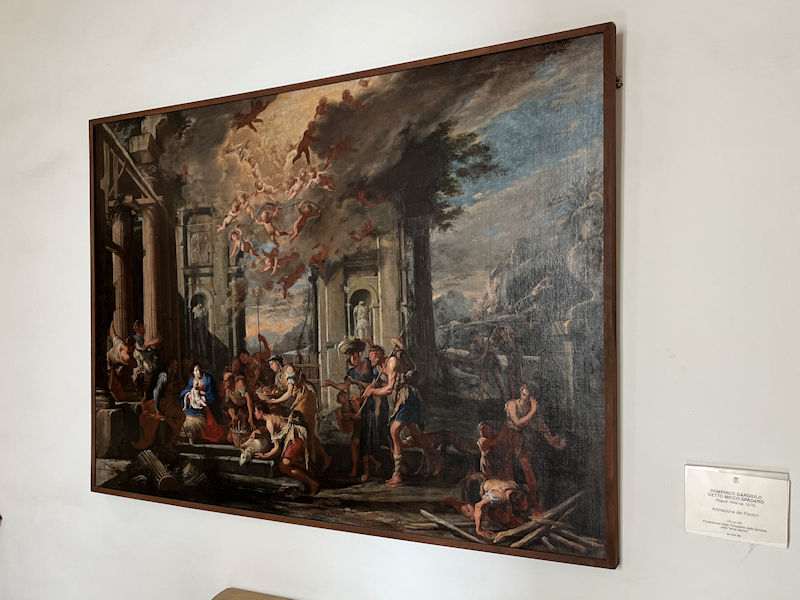
This is a strange 'Adoration of the Shepherds' by Micco Spadaro (Domenico Gargiulo, 1609-c.1675), with people scrambling out of the way and a raid of cherubs cascading.

Also by Micco Spadaro, 'Massacre of Carthusians and sacking of a charterhouse in England' (1638-1640) (presumably alluding to the suppression of the monasteries in England a century earlier)

The Castel Nuovo and Galleria Umberto I from a terrace. We'll take a break now and carry on anon.
Next up: More stuff from the monastery of San Martino



From Wikimedia Commons: A floor plan of the monastery: The first courtyard from the 'entrata' from the piazza is the light green rectangle; the pinkish part with numbering is the principal church and its various chapels (1 is the vestibule, 2 is for the nave); the purple square to the right is the Cloister of the Procurators (legal agents); the dark green represents the pharmacy; the large yellow square is the main cloister, with a smaller rectangle for the small monks' cemetery; the orange rooms were the Prior's quarters and the dark blue square was his garden; the light blue rooms everywere are now part of the National Museum of San Martino, some of them adopted from monastic cells.
The small salmon building at the bottom, on the far left in the photo of the Piazza San Martino above, is the 'Church for Women'.
A key to the numbering in the principal church is here.
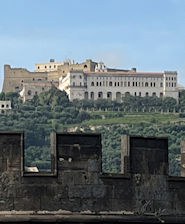 Dwight Peck's personal website
Dwight Peck's personal website





























































































